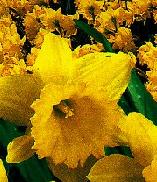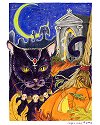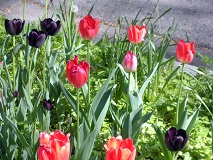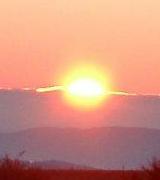
Wicca 101
As the Wheel Turns

Wicca and
The Eight Wiccan
Holidays
Wicca is a religion which pays homage to this
globe on which we dwell.
 |
Wicca 101 |
 |
|
|
Wicca
and neo-pagan
groups embrace a wide diversity of beliefs. This is as it should be, for
Wicca is not one of those religions which demand that you leave your brain
on the hat rack along with your hat as you fall into your circle. In fact,
one doesn't even have to have a circle. |
|
|
The ever-turning wheel of
the seasons is crucial, for with these seasons we sow and we reap. With
these seasons we live and die (at least, for the time being, symbolically!) |
|
Some Wiccan groups include
both male and female members, feeling that this is the best way to
incorporate the diverse energies of the different sexes. |
|
|
I cite the
World
Dancer, the last card of the Major Arcana of the tarot. The figure is
usually considered an androgine. There is a merging into the All. |
|
The Goddess is often
viewed in her 3 main aspects, all representing various stages of a woman's
life: |
|
Just as you don't have to
go to church to consider yourself a Christian, you don't need a coven/circle
to consider yourself a Wiccan. |
|
This person's "church"
might be the beholding of a sunrise, the mystery of the seasons, the daily
awakening of nature- perhaps a glimpse of the waning crescent moon, rising
just before daylight. |

|
|
******************************************************************************** (What MIGHT Wiccans actually DO on these days of special power? I certainly can't tell you what all Wiccans do! I would venture, tho, that most are having a jolly good time: getting together in circle; performing some rituals relating to the intent of the specific holiday; perhaps a bit of positive spell-casting, followed by consumption of lots of good food. The Wiccan belief that anything nasty you do comes back to you three times over would not encourage the performance of negative spells!) |
 |
Samhain (31 October), Halloween, is the New Year, usually viewed as the biggest holiday. It is the last of the 3 harvest feasts, following Lammas (1-2 August) and the Fall Equinox, when crops are gathered. Samhain is the last chance to gather any remaining crops. It is a holiday of feasting, yet a time when one recalls and honors the dead. Samhain feasts might have an empty place at the table where a spirit plate is set. |
|
Older legend points to the sacrificed king, who has been ploughed into the earth so that the next year's crops might be fertile. At Samhain, the veil between the living and the dead is thought to be at its thinnest, so that one might be able to communicate with the dead. (Christian holidays got superimposed on many of the Pagan holidays, as early Christianity tried to win converts by placing a Christian holiday atop an existing Pagan one. Christians celebrate All Saints Day 1 November and All Souls Day, 2 November. |
 |
Yule: Winter Solstice (The Wiccan holidays are approximately 45 -46 days apart: 45x 8 = 360, nearly the number of days in a year). Solstice falls on 21 December, give or take a day. The ancient Romans and Druids give us the custom of decoration of trees and hanging of mistletoe. The God is reborn. This God is the Sun, its mother being the Goddess. |
|
The light has returned. The Sun starts to wax. To celebrate the Sun's return, a Yule log might be burned. This is a holiday of rebirth, including our own spiritual rebirth. Yule is a time to ponder what personal seeds we want to plant within ourselves so that our own lives will re-seed us into the person that we desire to be. To paraphrase something that Carolyn Myss once said, if you are seeking a best friend who is (loving, caring, sensitive, intelligent, stimulating, vibrant, etc. etc, etc) -- then you have to build up in yourself the characteristics that you seek in the other. |
|
Imbolc/Candlemas
2 Feb.
The Sun Reborn. Brigid's Day |
 |
Ostara/Eostre/Alben
Eiler/Vernal or Spring Equinox. Lady's Day |
|
In some traditions, the
Lord and Lady are young and innocent, amidst all the rebirth around them.
They will have their handfasting (marriage) at the holiday of Beltane. (In
some pagan traditions Spring Equinox is the time of the sacred union of the
God and Goddess. The Goddess conceives. |
|
Easter |
 |
|
"Estrus" is the
condition for animals that are reproduction-ready, well-known to owners of
unspayed cats. Egg and rabbit are fertility symbols. The world is ablaze
with life; plants pop up; many animals conceive or give birth. |
 |
Summer Solstice, 21-23 June, Litha, Midsummer.Alban Heruin. The Wheel keeps turning,
and now everything is at its peak. The Lord and Lady are at their personal
peaks. This is the day of longest daylight (and shortest shadows). |
|
Yet, there is a certain
melancholy because, from this day forth, the days will get shorter. The
summer solstice, in our life cycle, represents the time of maturity,
adulthood, and full growth and power. This could be a time when we survey
whether we have strived to reach our full potential; what further work we
have to do; whether we are "stuck" as a result of some residue from our
childhood that is keeping us from reaching full maturity. Some of us have
encountered great trauma in childhood-abuse; severe parental neglect or
rejection. We can't just repress these things. But other persons might let
themselves be snagged up by a much lesser grievance, real or imagined.
Summer solstice might just be the time to say okay, I'm 40 years old, my
mother has been dead 20 years, I know she liked my brother better than she
liked me, and that's all right because I value mself. |
|
|
Lammas, Lughnassad- 1-2 August.
|
|
Maban, Autumn Equinox Alban Elfed. 20-23 September.
|
|
But now the days slide into
increasing darkness. This move toward the darkness, the lengthening shadows,
foretells the preparation of the old God to meet his death on Samhein. He
will metaphorically die and be plowed under the fields, a sacrifice to
assure fertility of next year's harvest. |